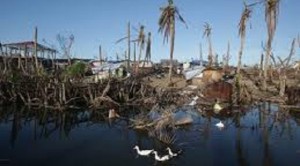WASHINGTON, DC – Tens of thousands of Filipinos affected by Typhoon Haiyan could lose their homes and livelihoods, unless a controversial government policy is changed immediately, according to a recent report by international refugee assistance group.
In its latest report, “Philippines: Typhoon Survivors Face Obstacles to Recovery,” Refugees International (RI) urges the Philippine government to ensure that the rights of people in so-called “no build zones” are respected, and that any relocations take place in a legal and humane fashion.
“Many Filipinos who live near the ocean lost everything in Typhoon Haiyan, and many want to be relocated,” said RI Climate Displacement Program Manager Alice Thomas.
“But the government’s current approach is unrealistic and possibly illegal. There is nowhere near enough available land for the 60,000 families who previously lived in these areas. So if this policy goes forward, it could lead to forced displacement, making recovery for thousands of affected people far more difficult,” Thomas explained.
In response to the devastation caused by Haiyan, the Philippine government declared that no homes could be built within 40 meters of the high-water mark in typhoon-affected coastal areas.
Manila’s stated intent was to prevent deaths during future storms – which may become more frequent and severe due to climate change.
Yet the decision in its current form has little legal or scientific basis and may be impossible to implement, RI stated.
This week, the Philippine government announced that it may revisit its no build zone policy, but gave no further details. RI calls on donor countries and the United Nations to work with Philippine authorities to find a suitable alternative.
“As climate change continues and coastal nations across the world are threatened, millions of people may face the prospect of relocation,” Thomas said.
“Yet governments and humanitarians have no good strategies for deciding where, when, and how relocation should be carried out,” Ms. Thomas added.
“That is why observers are watching the Philippines closely, and why the government must find a way to protect people from disasters while protecting their rights.”
RELATED STORIES
DOJ asked to issue legal opinion vs no-build zone policy
Roxas airs concern over ‘No-Build Zone’ order
Gov’t declares coastlines no-build zones
WASHINGTON, DC – Tens of thousands of Filipinos affected by Typhoon Haiyan could lose their homes and livelihoods, unless a controversial government policy is changed immediately, according to a recent report by international refugee assistance group.
In its latest report, “Philippines: Typhoon Survivors Face Obstacles to Recovery,” Refugees International (RI) urges the Philippine government to ensure that the rights of people in so-called “no build zones” are respected, and that any relocations take place in a legal and humane fashion.
“Many Filipinos who live near the ocean lost everything in Typhoon Haiyan, and many want to be relocated,” said RI Climate Displacement Program Manager Alice Thomas.
“But the government’s current approach is unrealistic and possibly illegal. There is nowhere near enough available land for the 60,000 families who previously lived in these areas. So if this policy goes forward, it could lead to forced displacement, making recovery for thousands of affected people far more difficult,” Thomas explained.
In response to the devastation caused by Haiyan, the Philippine government declared that no homes could be built within 40 meters of the high-water mark in typhoon-affected coastal areas.
Manila’s stated intent was to prevent deaths during future storms – which may become more frequent and severe due to climate change.
Yet the decision in its current form has little legal or scientific basis and may be impossible to implement, RI stated.
This week, the Philippine government announced that it may revisit its no build zone policy, but gave no further details. RI calls on donor countries and the United Nations to work with Philippine authorities to find a suitable alternative.
“As climate change continues and coastal nations across the world are threatened, millions of people may face the prospect of relocation,” Thomas said.
“Yet governments and humanitarians have no good strategies for deciding where, when, and how relocation should be carried out,” Ms. Thomas added.
“That is why observers are watching the Philippines closely, and why the government must find a way to protect people from disasters while protecting their rights.”
RELATED STORIES
https://newsinfo.inquirer.net/579667/doj-asked-to-issue-legal-opinion-vs-no-build-zone-policy
https://newsinfo.inquirer.net/534607/roxas-disputes-aquinos-no-build-zone-order
https://newsinfo.inquirer.net/534035/govt-declares-coastlines-no-build-zones


